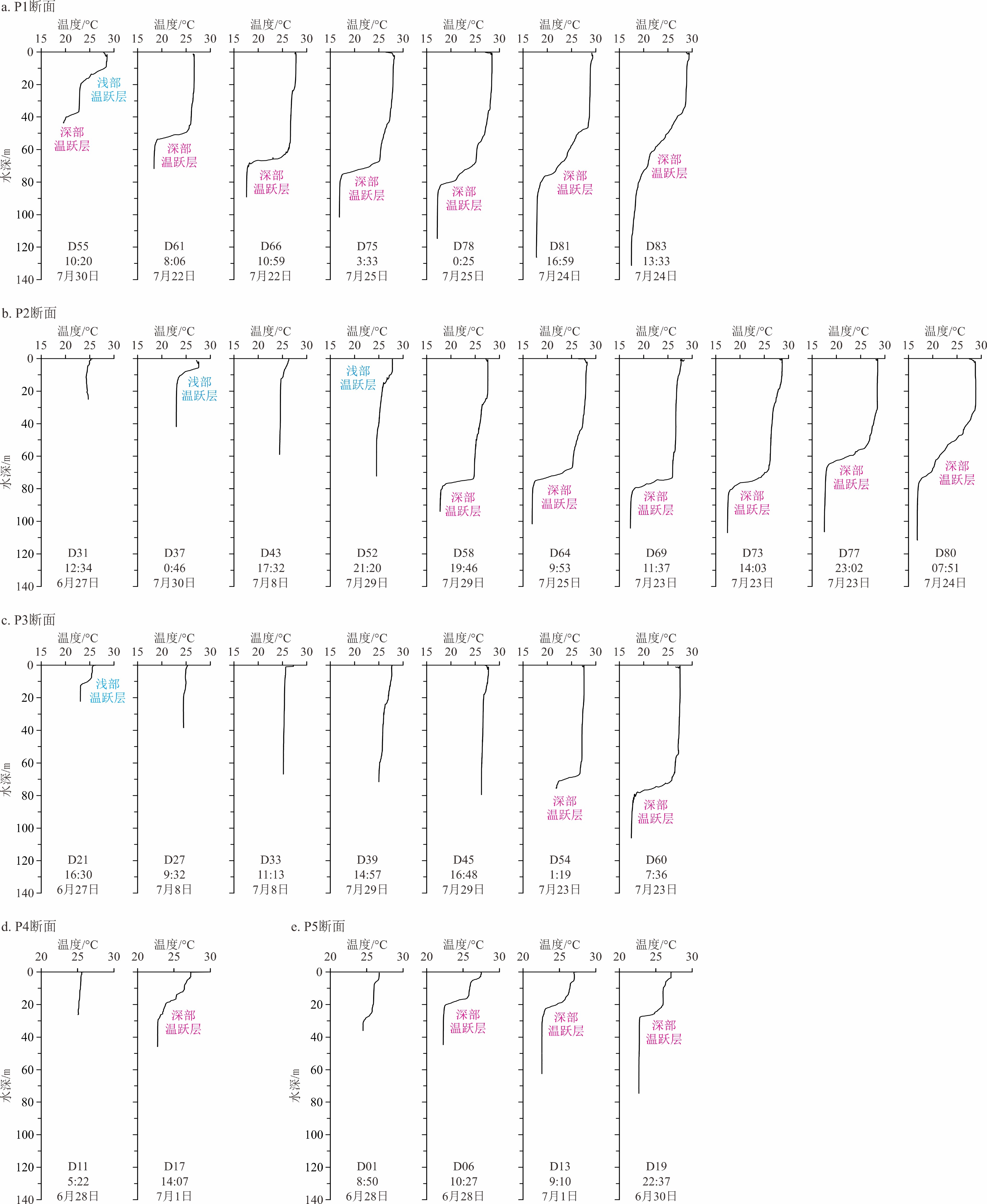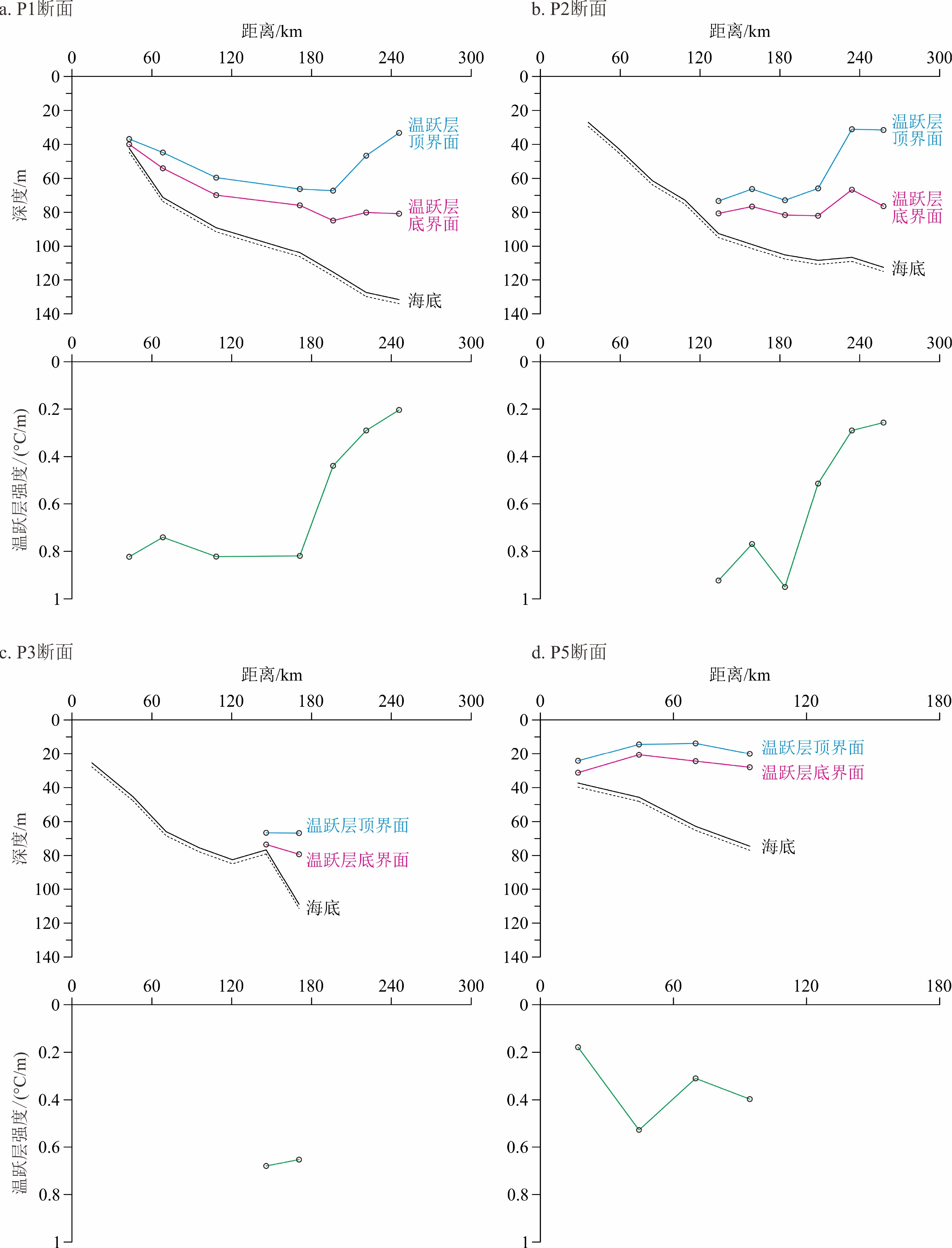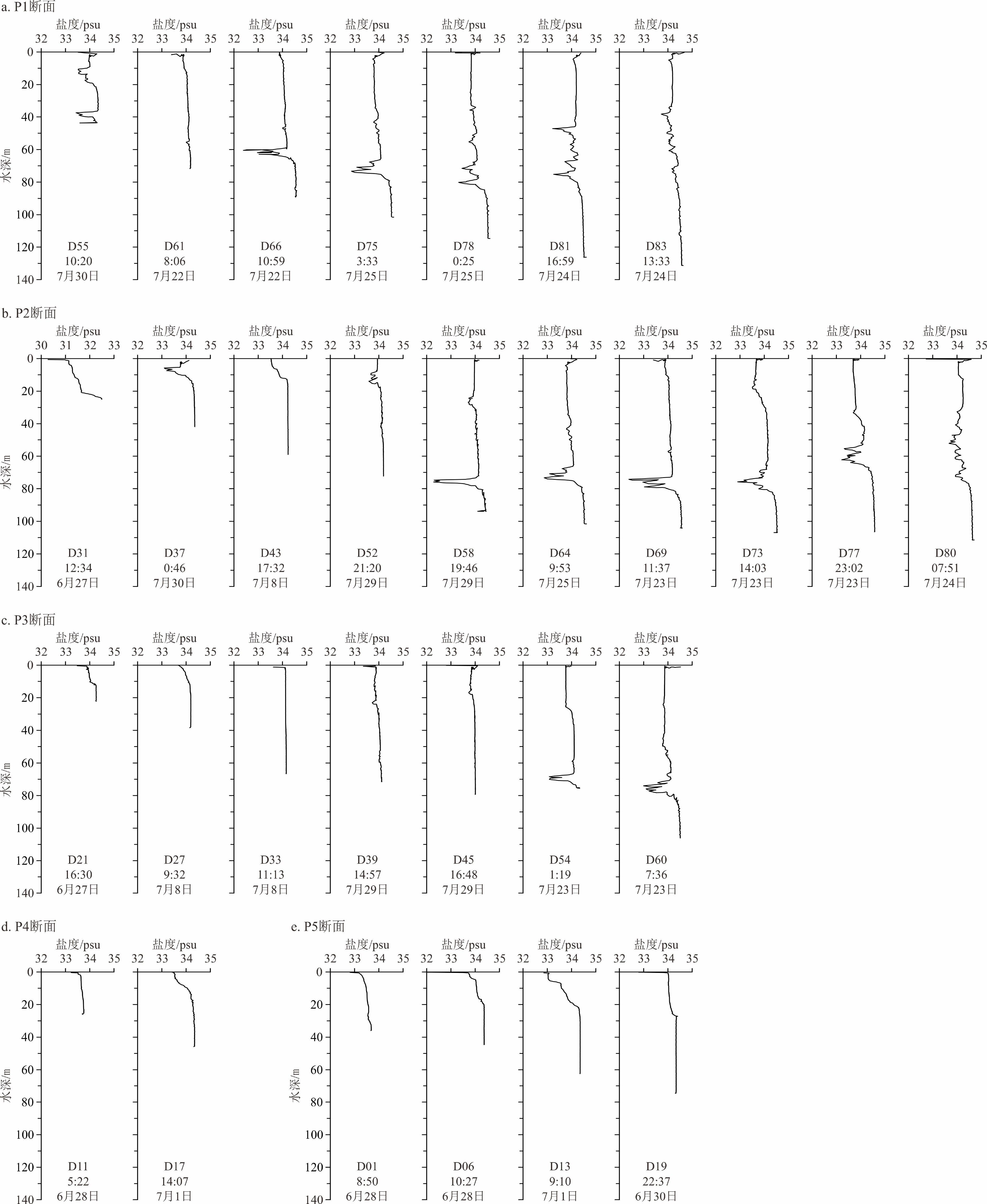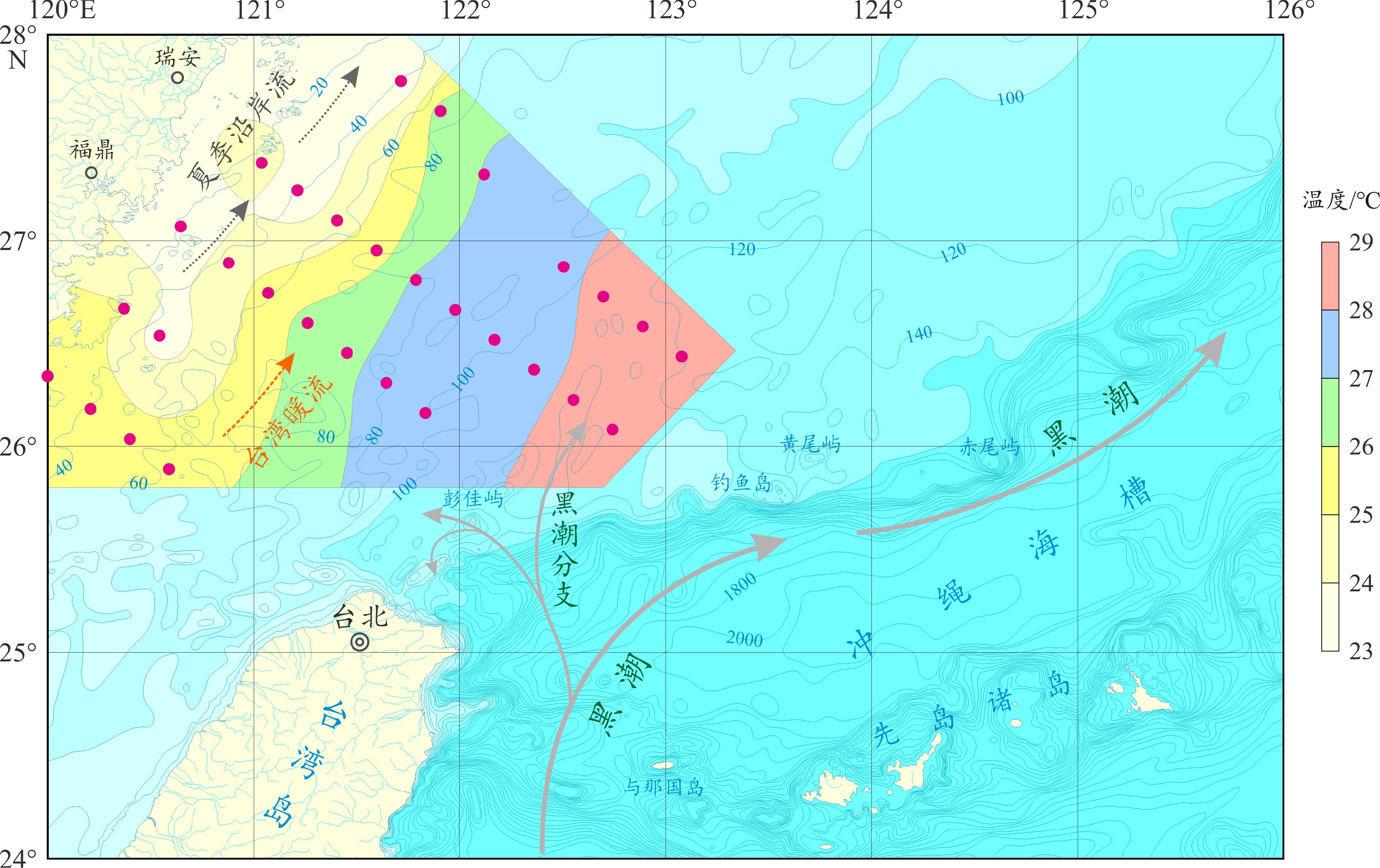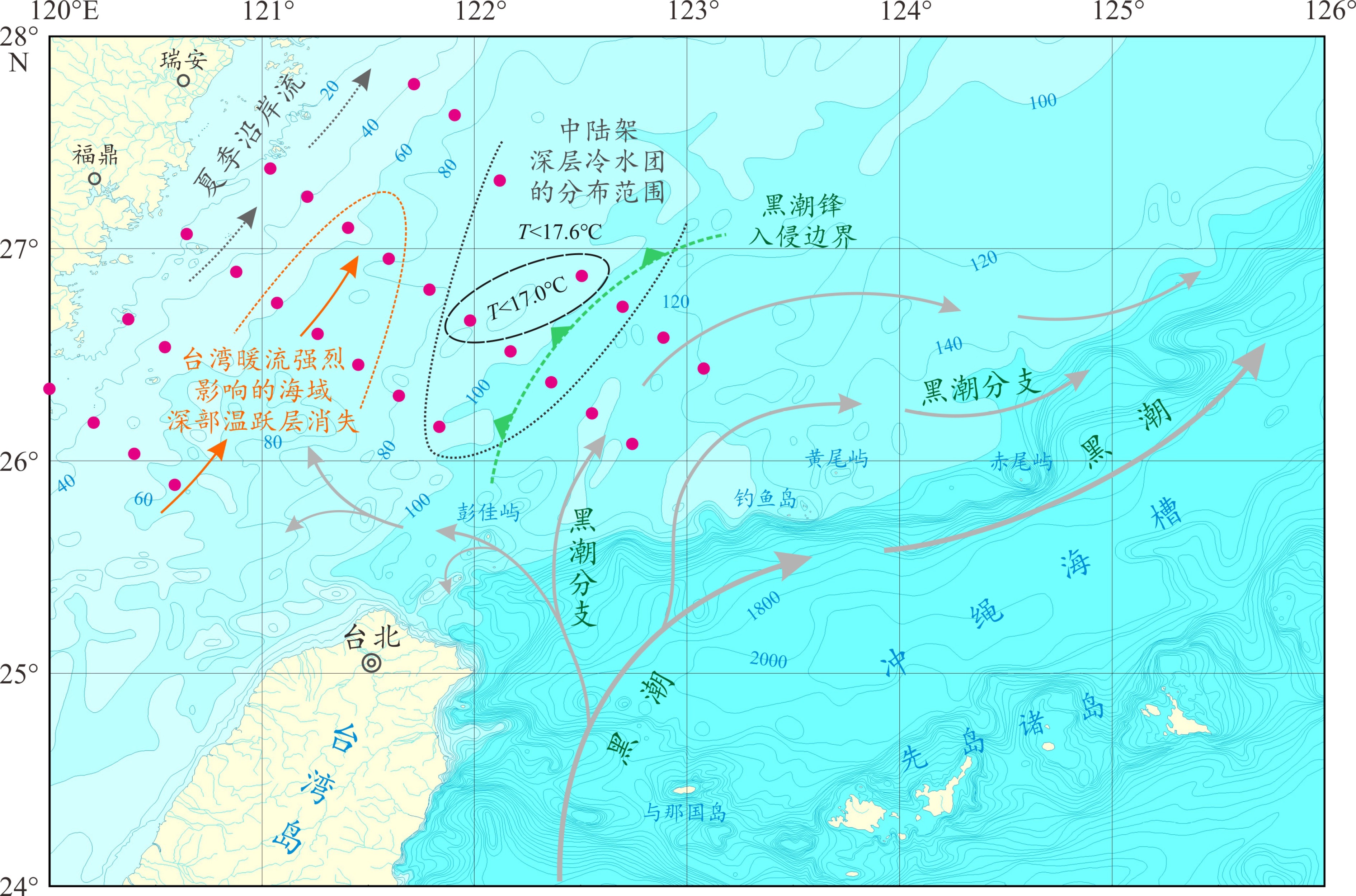The summer thermohaline structure of 2011 of the southern East China Sea shelf and its implications for the intrusion of Taiwan Warm Current and Kuroshio Current
-
摘要: 利用2011年7月5个断面共30个站位的温盐深(CTD)测量资料,分析东海南部陆架水体的温盐结构和温跃层特征,探讨黑潮和台湾暖流对东海陆架水文状况的影响。结果显示,本区广泛存在着浅部温跃层和深部温跃层。浅部温跃层分布于20 m水深以内,跃层强度普遍较弱,具有明显的日内生消变化。深部温跃层分布于中、外陆架和台湾海峡。在中、外陆架的深水区,跃层底界深度约80 m,跃层厚度约10 m;跃层强度大,约为0.8 ℃/m,且较为稳定。在台湾海峡北部,温跃层分布于水深14~30 m,跃层厚度6~10 m,跃层强度偏弱,为0.2~0.5 ℃/m。在温跃层附近,由于上、下层水团温度、盐度的差异,其混合过程常出现盐指现象。在东海陆架90~110 m等深线之间,深部温跃层之下盘踞着一个深层冷水团,水温为16.8~17.6 ℃。黑潮水的入侵,使得外陆架温跃层强度减弱至0.2~0.5 ℃/m;同时,跃层层位上升,厚度加大。温跃层强度可以作为指示黑潮入侵的灵敏指标。当夏季深部温跃层强度低于0.6 ℃/m,同时伴随跃层厚度加大时,可判别为黑潮入侵。本区夏季黑潮锋可以到达110 m等深线附近。在中陆架50~80 m等深线之间,深部温跃层的消失,说明台湾暖流的强烈影响遍及整个水柱;而从南向北,台湾暖流的影响逐渐减弱。台湾海峡北部深层水温度较低,平均值为22.52 ℃,要比东海南部中陆架深层水低3 ℃,这可能意味着台湾暖流深层水主要源于黑潮分支的加入。Abstract: Conductivity–temperature–depth (CTD) measurements along 5 transects including 30 hydrographic stations were carried out over the continental shelf of the southern East China Sea in July 2011. The thermohaline structure of waters and its characteristics are analyzed and the influence of the Kuroshio Branch Current and the Taiwan Warm Current on the hydrography of the shelf water discussed. Results show that shallow and deep thermoclines occur extensively. The former is present within 20 m in water depth, with weak gradients but apparent intraday evolution. The latter is present over the mid and outer shelf and the Taiwan Strait. The lower boundary of deep thermocline dwells at the water depth of ~80 m over the mid and outer shelf. It has a thickness of ~10 m, with stable and strong gradients of ~0.8 ℃/m. In contrast, deep thermocline dwells at the depths between 14~30 m in the northern Taiwan Strait. Its thickness usually varies between 6~10 m, with relatively weak gradients between 0.2~0.5 ℃/m. Salt fingering is observed around the deep thermocline due to the differences in temperature and salinity between the upper and lower waters. A cold water mass is observed below deep thermoclines at the isobaths between 90~110 m, with temperature between 16.8~17.6 ℃. The gradients of deep thermocline drop to 0.2~0.5 ℃/m over the outer shelf, their strata are synchronously lifted, and their thicknesses expanded, indicating the consequence of the Kuroshio intrusion. Therefore, once the deep thermocline gradient is lower than 0.6 ℃/m coupled with expanded thickness of its stratum, the Kuroshio intrusion will be distinguished. As a sensitive proxy, weakened thermocline gradients indicate that the Kuroshio front may reach up to the 110 m isobath over the outer shelf in summer. Disappearance of deep thermocline demonstrates that the Taiwan Warm Current prevails throughout the water column over the mid shelf at the isobaths between 50~80 m. Its influence reduces gradually from south to north. The deep water in the northern Taiwan Strait has a lower mean temperature of 22.52 ℃, which is 3 ℃ much lower than that of the deep water in the mid shelf of the southern East China Sea. Such a discrepancy suggests that the deep water of the Taiwan Warm Current may be derived from the inflow of the Kuroshio Branch Current.
-
东海大陆架宽阔,但其南部陆架宽度逐渐收窄,福建闽江口至台湾北部的花瓶屿宽度降至240 km。地形自大陆岸线向东南缓慢倾斜,60 m等深线以浅为内陆架,陆架外缘坡折处水深140~180 m[1](图1)。东海南部陆架环流和水团分布,主要受近海的浙闽沿岸流和黑潮、台湾暖流等外海流系控制,三者相互作用,水文状况复杂,是研究外海流系对我国近海水文状况影响的首选海域。
浙闽沿岸流在冬季源于长江口和杭州湾一带,由长江、钱塘江的入海径流与海水混合而成,沿途还有瓯江、闽江等河流淡水的加入,主要分布于东海30 m等深线以内[2]。受东亚季风等因素的影响,其势力冬强夏弱,强度和流向具有明显的季节性变化。冬季盛行偏北风,沿岸流向南流动,流向稳定,流速较强,流幅较窄。夏季,东海南部盛行西南风,沿岸流顺海岸向东北方向流动。春、秋季,是季风交替的时期,风向零乱、不稳定,沿岸流流向多变。沿岸水混浊,透明度低,盐度通常低于31.5 psu[2],从近岸向外海递增。温度随季节而改变,近岸在潮混合作用下温度垂向分布均匀,较深海域出现层化,形成温跃层[3]。
黑潮是北太平洋一支强大而稳定的西边界流,起源于菲律宾以东海域,经台湾苏澳和与那国岛之间的水道进入东海,并沿东海陆架外缘向东北向流动,后穿越吐噶喇海峡返回太平洋。黑潮具有高温、高盐、高流速、大流量等特征,它通过动能、热能和物质交换[4-5],对东海南部陆架环流和水文结构产生了显著影响[6]。在东海南部陆架海域,常年存在着黑潮水的入侵现象[7-11](图1),而且冬季入侵事件要比夏季更频繁[12]。当黑潮自台湾以东进入东海后,其西倾的等压面突然失去了台湾海岸的支撑,迫使黑潮在台湾东北海域进行空间上的地转调整,进而出现入侵陆架的现象[13-14]。黑潮分支的入侵能够保持区域动量守恒,其反气旋型涡旋的存在使得台湾东北海域形成稳态的流场[15]。入侵陆架的黑潮水主要是黑潮表层水,其次是黑潮次表层水。东海黑潮表层水深度一般为0~100 m。其温度、盐度具有明显的季节性变化,夏季分别为28~29 ℃和34.2~34.7 psu;冬季分别为18~24.5 ℃和34.5~34.9 psu[3]。东海黑潮次表层水位于表层水之下至400 m深处,温度、盐度分别为14.4~20.5 ℃和34.4~34.9 psu,性质较为稳定。
台湾暖流存在于浙闽沿岸流和黑潮之间的陆架上,大致沿50~100 m等深线向北流。其流速稳定,具有夏强冬弱的特征。台湾暖流终年存在,即使在冬季偏北风强盛的时候,表层以下也可以观测到0.5节的北向流速[3]。台湾暖流起源于台湾东北海域入侵的黑潮分支和从台湾海峡北部流出的暖水,黑潮分支为主要源泉[16-18]。台湾暖流流经的海域为陆架混合水,它介于沿岸水与黑潮水之间,呈过渡性质。
2011年夏季,我们在东海南部陆架海域布设了5条CTD断面,共计30个站位。本次调查时间段集中,站位较多,其分布基本控制了东海南部广阔的陆架海域,包括台湾海峡北部出口。本文的目标是通过温盐深测量,了解夏季东海南部陆架水体的温盐结构,分析温跃层的水深分布及其强度变化,探讨黑潮和台湾暖流对东海陆架水文状况的影响。
1. 数据与方法
2011年6月27日至7月30日,利用“兴业号”考察船,在东海南部浙江温州至福建宁德以东海域进行了大范围的温盐深(CTD)定点测量,从内陆架向外陆架布设5条断面,共计30个站位(图1)。温盐深测量采用日本Alec Electronics公司的ASTD687型和加拿大RBR公司的XR-420型水质剖面仪。通过电动绞车悬挂入水,感温1~3 min,从海面匀速降至海底,下放速度控制在1 m/s以内,随后再提升至海面。水文采样频率为4~5 Hz,主要观测参数包括温度、电导率、盐度、深度和浊度等,以仪器下降阶段获取的数据为正式测量值。温度测量的准确度为± 0.02 ℃,分辨率为0.001 ℃。盐度的准确度为± 0.02 psu,分辨率为0.005 psu。调查期间,未遭遇台风或热带风暴过境,但部分时段风浪较大、海况较差,当无法满足作业要求时,回港避风。
跃层顶界、底界的划分和跃层强度的计算,采用《海洋调查规范—海洋调查资料处理(GB12763.7-91)》[19]推荐的垂向梯度法,即选择温度或盐度垂向剖面上曲率最大的拐点作为临界点。在水深<200 m范围内,温跃层强度最低标准为0.2 ℃/m;盐跃层强度最低标准为0.1 psu/m。
2. 结果与讨论
2.1 温度剖面特征
在东海南部30个站位的温度垂向剖面上,可观察到两种类型的温跃层:浅部温跃层和深部温跃层(图2)。深部跃层强度大,为主跃层;而浅部跃层普遍较弱,为次跃层。
浅部温跃层主要分布于内陆架浅水区,跃层存在的水深范围通常在20 m以内。夏季强烈的太阳辐射使得表层海水升温,在波浪和潮流的混合作用下形成上均匀层,其下界存在温度梯度,进而产生温跃层。跃层强度较弱,通常在0.2 ℃/m以内,最大值约0.5 ℃/m,如P1断面的D55站位。这类跃层的存在受太阳辐射强度和表层水动力状况的影响很大,具有明显的日内生消变化。
深部温跃层是本区主要的跃层类型,分布于中、外陆架和台湾海峡。在中、外陆架,跃层底界在深水区较为稳定,深度一般在80 m附近;跃层强度大,且较为稳定,约为0.8 ℃/m(图3)。向陆方向随着海底地势变浅,跃层底界逐渐抬高,但跃层强度保持不变。跃层厚度通常为10 m 左右,向陆方向随着水深变浅,有缓慢减薄的趋势。然而,在外陆架110 m等深线以外,跃层顶界向上快速迁移,跃层厚度显著加大,跃层强度从约0.8 ℃/m减弱至约0.2 ℃/m。在台湾海峡北部,跃层分布较浅,一般在水深14~30 m之间,跃层厚度6~10 m,跃层强度较弱,通常为0.2~0.5 ℃/m(图3)。深部温跃层一般由不同性质的水团相互叠置所形成,其界面存在温度等水文要素的明显的梯度变化。这类跃层分布于深水层位,强度大,在夏季较为稳定,具有季节性特征。
2.2 盐度剖面特征
沿岸站位盐度明显偏低,垂向波动较大;中外陆架站位盐度偏高,垂向波动小(图4)。盐度垂向波动幅度最大的层位明显对应于深部温跃层(图3)。在温跃层附近,由于相邻水团温度、盐度的差异,其混合过程常出现盐指现象[20]。当跃层强度大、跃层厚度薄时,常出现单一的、强的盐度低谷值,比如,P1断面的D66和D75站位,P2断面的D58、D64、D69和D73站位,P3断面的D60站位;而当跃层强度较小、跃层较厚时,常出现一簇弱的盐度低谷值,比如,P1断面的D78、D81和D83站位,P2断面的D77和D80站位。此外,在深部温跃层的上、下水团之间,存在明显的盐度差异。中、外陆架上层水盐度为34.1~34.2 psu,深层水盐度为34.4~34.6 psu,深层水盐度要比上层水高0.3~0.4 psu。
2.3 中陆架深层冷水团
温度垂向剖面显示,浅部温跃层和深部温跃层之间的水温较为稳定,这里以25 m水深附近的平均温度作为代表,指示研究区内上层水体温度的分布特征。水温平面分布显示,从东海内陆架向东南部外陆架,上层水温逐渐升高,存在明显的温度梯度(图5)。内陆架水受浙闽沿岸流控制,温度较低,一般为23~25 ℃。外陆架水明显受到黑潮的影响,其温度可达28~29 ℃,台湾海峡北部,水温为25~26 ℃。
深部温跃层之下的深层水温度非常稳定(图2)。这里以90 m水深附近的平均温度指示深层水的温度特征。水温分布表明,在中陆架90~110 m等深线,盘踞着一个低温水团,其温度低于17.6 ℃,核心区深层水温为16.87 ℃(图6)。该水团盐度为34.50 psu,与周边水体差别不大。
中陆架深层冷水团可以认为是残留在温跃层之下的冬季深层冷水,自南往北因混合作用而逐步变性。它能延续至夏季,有其自身存在的有利条件:(1)从动力学机制上看,中陆架处于浙闽沿岸流和北向的黑潮两股势力之间,易形成气旋型涡旋[3],而涡旋核心即对应于冷水团的中心区域;(2)从热力学机制上看,冷水团上部存在着稳定的强温跃层(图2),对垂向热对流有明显的抑制作用;(3)从水深和地形上看,水深较大(>90 m),受到潮汐和波浪的混合搅拌作用弱;中陆架80~110 m等深线之间的地形为宽缓的平台(图1),坡度小,也有利于深层冷水团的稳定存在。
2.4 黑潮对东海外陆架的入侵
东海黑潮大致沿陡峻的大陆坡朝东北方向流动,流轴常位于海底坡度最陡处,对应于温度场水平梯度的最大值[2]。进入东海后,黑潮自身的地转调整是产生北向的黑潮分支的根本原因,用以平衡斜压与地形联合效应、海底摩擦和非线性平流作用[15]。因此,黑潮分支侵入东海南部陆架的现象是常年存在的。本次调查显示,在东海外陆架的6个站位,随着水深的加大,跃层强度明显减弱,从约0.5 ℃/m降至0.2 ℃/m;同时,跃层层位上升,厚度逐渐加大(图3)。外陆架水文结构的变化实际上反映了黑潮表层水的入侵。实测数据表明,夏季黑潮锋的位置可以到达110 m等深线附近的陆架海域(图6)。
2.5 台湾暖流的影响
通过观察P1、P2、P3断面深部温跃层出现频率和跃层底界水深变化(图2、图3)可以发现,南部P3断面仅有2个站位出现跃层,且水深较大;P2断面跃层出现频率明显增加;而北部P1断面跃层出现的频率最高,在40 m水深即出现跃层,这表明在50~80 m等深线之间的中陆架,从南向北存在着深部温跃层出现频率增加和跃层深度逐渐变浅的现象,我们推测这可能反映了台湾暖流的影响。台湾暖流常年存在于浙闽沿岸流和黑潮之间[18],大致沿着水深50~100 m的中陆架北流。以P3断面为例,在水深30 m附近,台湾暖流控制区要比浙闽沿岸流区水温高1~2 ℃。深部温跃层的消失,说明台湾暖流对水柱的影响强烈,其影响范围可以达到水深80 m以下,遍及整个水体。而从南向北,台湾暖流的影响在逐渐减弱,可能仅局限于水体上层,甚至根本就不存在(图6)。由于站位分布于28°N以南,本次调查并未观察到文献[13]上所报道的台湾暖流的分支现象。
台湾暖流从台湾海峡北部流出,沿着福建海岸向东北方向流动,夏季流量最大,月平均体积输送接近3 Sv[21],流速可达35~40 cm/s[22]。通过比较P5和P3断面的温盐结构,可以观察台湾暖流北上过程中的变化。海峡北部P5断面存在温跃层,深层水温度明显偏低,比如,D06、D13和D19站位的深层水温度分别为22.29 、22.60 和22.68 ℃,平均水温22.52 ℃。而东海南部P3断面中部,无深部温跃层,水温垂向分布均匀,D33、D39和D45站位的深层水温度分别为25.20 、25.07 和26.30 ℃。P3断面中部深层水平均温度为25.52 ℃,竟然比海峡北部P5断面深层水平均温度高3 ℃,这表明流出海峡的台湾暖流可能只是温跃层(约30 m水深)之上的表层水。研究表明,进入东海南部之后,台湾暖流流速明显减低,流幅加宽[14]。P3和P5断面之间深层水温度的显著差异,意味着中陆架深层水可能源于侧翼黑潮分支的加入[15](图6)。
3. 结论
(1)东海南部陆架海域夏季(7月)水体广泛存在浅部和深部温跃层。浅部温跃层分布于表层20 m水深以内,跃层强度普遍较弱,具有明显的日内生消变化。深部温跃层分布于中、外陆架和台湾海峡,在中、外陆架的深水区,跃层底界深度约为80 m,跃层厚度约为10 m;跃层强度大,约为0.8 ℃/m,且较为稳定。在台湾海峡北部,深部温跃层分布于水深14~30 m,跃层厚度6~10 m,跃层强度偏弱,为0.2~0.5 ℃/m。在温跃层附近,由于上、下层水团温度、盐度的差异,其混合过程常出现盐指现象。
(2)外陆架的深部温跃层强度明显减弱,降至0.2~0.5 ℃/m;同时,跃层层位上升,厚度增加;这些水文特征指示了黑潮水的入侵。温跃层强度可以作为表征黑潮入侵的灵敏指标。在东海南部外陆架,当夏季深部温跃层强度<0.6 ℃/m,同时伴随跃层厚度增加时,可判断为黑潮入侵。夏季黑潮锋的位置可以到达110 m等深线附近。在中陆架50~80 m等深线,深部温跃层的消失,说明台湾暖流的强烈影响遍及整个水柱;而从南向北,台湾暖流的影响逐渐减弱。台湾海峡北部深层水温度较低,平均值为22.52 ℃,要比东海南部中陆架深层水低3 ℃,这可能意味着台湾暖流深层水主要源于侧翼黑潮分支的加入。东海中陆架90~110 m等深线之间,盘踞着一个深层冷水团,其温度低于17.6 ℃,核心区深层水温为16.87 ℃。该水团盐度为34.50 psu,与周边水体差别不大。
-
-
[1] 李家彪. 东海区域地质[M]. 北京: 海洋出版社, 2008: 86-87. LI Jiabiao. Regional Geology of the East China Sea[M]. Beijing: China Ocean Press, 2008: 86-87.
[2] 孙湘平. 中国近海区域海洋[M]. 北京: 海洋出版社, 2006: 106-129, 272-291. SUN Xiangping. Regional Oceanography of China Seas[M]. Beijing: China Ocean Press, 2006: 106-129, 272-291.
[3] 苏纪兰, 袁业立. 中国近海水文[M]. 北京: 海洋出版社, 2005: 214-221, 229-244. SU Jilan, YUAN Yeli. Offshore Hydrology in China[M]. Beijing: China Ocean Press, 2005: 214-221, 229-244.
[4] Chern C S, Wang J, Wang D P. The exchange of kuroshio and East China Sea shelf water [J]. Journal of Geophysical Research: Oceans, 1990, 95(C9): 16017-16023. doi: 10.1029/JC095iC09p16017
[5] Wang W T, Yu Z M, Song X X, et al. Intrusion pattern of the Offshore Kuroshio Branch Current and its effects on nutrient contributions in the East China Sea [J]. Journal of Geophysical Research: Oceans, 2018, 123(3): 2116-2128. doi: 10.1002/2017JC013538
[6] Saito H. The kuroshio: its recognition, scientific activities and emerging issues[M]//Nagai T, Saito H, Suzuki K, et al. Kuroshio Current: Physical, Biogeochemical, and Ecosystem Dynamics. Washington, D C: Geophysical Monograph Series, 2019, doi: 10.1002/9781119428428.ch1.
[7] Hsueh Y, Wang J, Chern C S. The intrusion of the Kuroshio across the continental shelf northeast of Taiwan [J]. Journal of Geophysical Research: Oceans, 1992, 97(C9): 14323-14330. doi: 10.1029/92JC01401
[8] Hsin Y C, Wu C R, Shaw P T. Spatial and temporal variations of the Kuroshio east of Taiwan, 1982-2005: a numerical study [J]. Journal of Geophysical Research: Oceans, 2008, 113(C4): C04002. doi: 10.1029/2007JC004485
[9] Yang D Z, Yin B S, Liu Z L, et al. Numerical study of the ocean circulation on the East China Sea shelf and a Kuroshio bottom branch northeast of Taiwan in summer [J]. Journal of Geophysical Research: Oceans, 2011, 116(C5): C05015. doi: 10.1029/2010JC006777
[10] Wang J, Oey L Y. Inter-annual and decadal fluctuations of the Kuroshio in East China Sea and connection with surface fluxes of momentum and heat [J]. Geophysical Research Letters, 2014, 41(23): 8538-8546. doi: 10.1002/2014GL062118
[11] Yang D Z, Huang R X, Yin B S, et al. Topographic beta spiral and onshore intrusion of the Kuroshio Current [J]. Geophysical Research Letters, 2018, 45(1): 287-296. doi: 10.1002/2017GL076614
[12] Wu C R, Hsin Y C, Chiang T L, et al. Seasonal and interannual changes of the Kuroshio intrusion onto the East China Sea Shelf [J]. Journal of Geophysical Research: Oceans, 2014, 119(8): 5039-5051. doi: 10.1002/2013JC009748
[13] 苏纪兰, 潘玉球. 台湾以北陆架环流动力学初步研究[J]. 海洋学报, 1989, 11(1):1-14 SU Jilan, PAN Yuqiu. Preliminary study on the circulation dynamics over the continental shelf north of Taiwan [J]. Acta Oceanologica Sinica, 1989, 11(1): 1-14.
[14] 苏纪兰. 中国近海的环流动力机制研究[J]. 海洋学报, 2001, 23(4):1-16 SU Jilan. A review of circulation dynamics of the coastal oceans near China [J]. Acta Oceanologica Sinica, 2001, 23(4): 1-16.
[15] Cui X, Yang D Z, Sun C J, et al. New insight into the onshore intrusion of the Kuroshio into the East China Sea [J]. Journal of Geophysical Research: Oceans, 2021, 126(2): e2020JC016248. doi: 10.1029/2020JC016248
[16] Chen C T A, Sheu D D. Does the Taiwan warm current originate in the Taiwan strait in wintertime? [J]. Journal of Geophysical Research: Oceans, 2006, 111(C4): C04005. doi: 10.1029/2005JC003281
[17] Jan S, Sheu D D, Kuo H M. Water mass and throughflow transport variability in the Taiwan Strait [J]. Journal of Geophysical Research: Oceans, 2006, 111(C12): C12012. doi: 10.1029/2006JC003656
[18] Lian E G, Yang S Y, Wu H, et al. Kuroshio subsurface water feeds the wintertime Taiwan Warm Current on the inner East China Sea shelf [J]. Journal of Geophysical Research: Oceans, 2016, 121(7): 4790-4803. doi: 10.1002/2016JC011869
[19] 国家技术监督局. GB12763.7-1991 海洋调查规范 海洋调查资料处理[S]. 北京: 中国标准出版社, 1992: 68-70. State Bureau of Technical Supervision. GB12763.7-1991 The Specification for Oceanographic Survey-Oceanographic Survey Data Processing[S]. Beijing: Standards Press of China, 1992: 68-70.
[20] Sorkin A, Sorkin V, Leizerson I. Salt fingers in double-diffusive systems [J]. Physica A: Statistical Mechanics and its Applications, 2002, 303(1-2): 13-26. doi: 10.1016/S0378-4371(01)00396-X
[21] Chen H W, Liu C T, Matsuno T, et al. Temporal variations of volume transport through the Taiwan Strait, as identified by three-year measurements [J]. Continental Shelf Research, 2016, 114: 41-53. doi: 10.1016/j.csr.2015.12.010
[22] Katoh O, Morinaga K, Nakagawa N. Current distributions in the southern East China Sea in summer [J]. Journal of Geophysical Research: Oceans, 2000, 105(C4): 8565-8573. doi: 10.1029/1999JC900309
-
期刊类型引用(1)
1. 赵芃,蒋日进,印瑞,刘明智,龙翔宇,单晓鸾,张秋宏,郝辉擘,李齐群. 七星列岛产卵场保护区鱼卵、仔稚鱼种类组成及其与环境因子的关系. 中国水产科学. 2023(11): 1311-1326 .  百度学术
百度学术
其他类型引用(6)



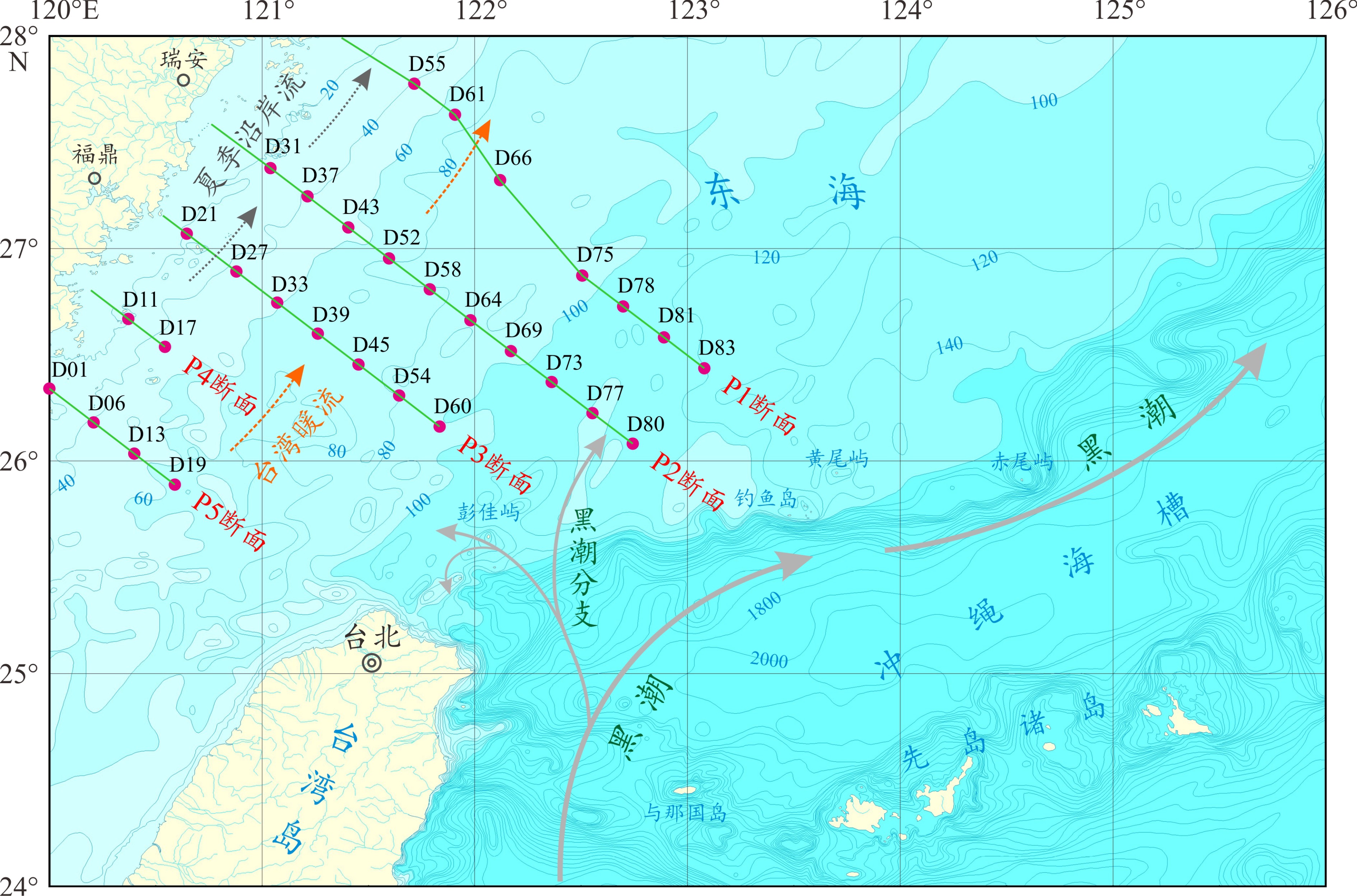
 下载:
下载:
